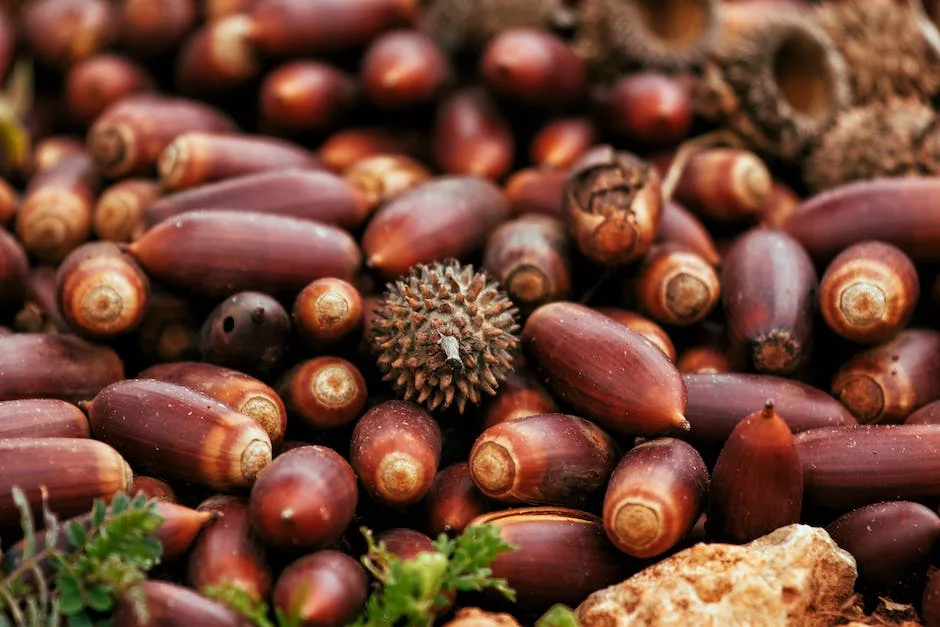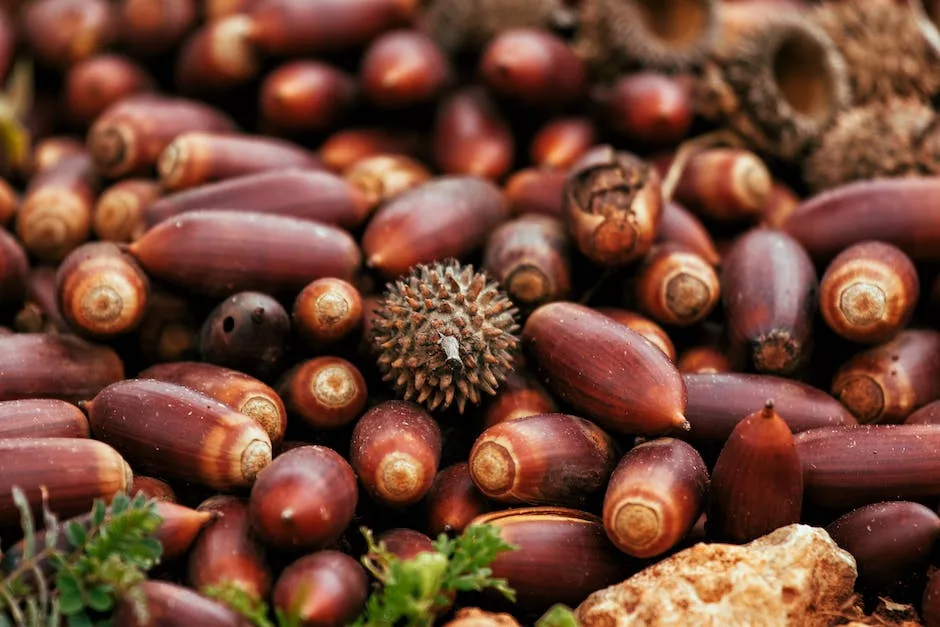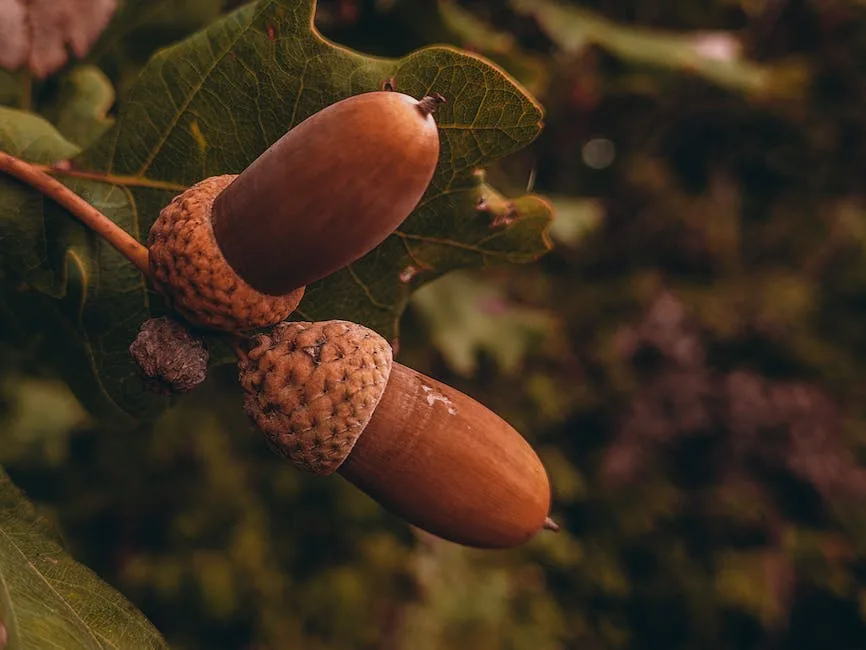Acorns are considered a nut and are edible. The tannin levels in acorns can make them very bitter, so they are often leached before being eaten. When leached of their tannins, acorns can be cooked and eaten like any other nut. They can also be ground into a flour and used in baking.
Technically, all acorns are edible, but some species are more palatable than others. The tannin content in acorns can make them bitterly unpalatable, but leaching or boiling the acorns can draw out the tannins and make them more palatable. The acorns from white and red oaks are generally considered to be the most palatable, while acorns from black oaks are typically the least palatable.
Can you eat acorns off of Oak Tree?
Acorns are a nutritious food source that are high in iron and manganese. However, raw acorns contain tannins which can be toxic if consumed in large quantities. Tannins can be removed by boiling or soaking the acorns, which will make them safe to eat. Roasted acorns make a delicious snack, and can also be ground into flour.
Acorns are a versatile food source that can be used in a variety of ways. They can be eaten whole, ground up into meal or flour, or made into mush to extract their oil. Once you’ve safely leached the tannins from your raw acorns, you can roast them for a snack.
How do you prepare acorns to eat
If you’re looking for a tasty and nutritious snack, look no further than roasted acorns! Acorns are packed with vitamins and minerals, and roasting them brings out their delicious nutty flavor.
To roast acorns, simply preheat your oven to 350 degrees Fahrenheit, pour the acorns into a single layer on an ungreased, rimmed cookie sheet, and cook for about 60 minutes or until they turn a chocolate brown color. Remove from the oven and let cool, then salt to taste. Enjoy!
Acorns from oak trees and their close relatives in the Lithocarpus genus are both edible. For foraging purposes, it is not necessary to distinguish between the two.
Do acorns taste good?
Raw acorns are very bitter and gritty and must be processed prior to eating. Acorns that are leached or roasted are nutty and sweet. For some people, the taste of leached acorns is similar to that of boiled potatoes. While many oak species give bitter-tasting acorns, some produce sweeter nuts like European white oaks.
Acorns are a great source of energy and protein, and contain many essential vitamins and minerals. They are a good choice for a wild, edible food for foraging.
What happens if I eat a raw acorn?
Acorns are a source of food for many animals, including humans. However, consuming acorns can be dangerous due to the high tannic acid content. Tannins are bitter substances that can irritate human membranes and organs, particularly the kidneys, if consumed in large enough quantities. Therefore, it is essential to leach acorns before consumption to remove the tannic acid. When acorns are properly leached, they can be a healthy and nutritious part of the diet.
Now hot leaching acorns is simple. Put the acorns in a pan of water, heat it to boiling, drain off the water and repeat. This will remove most if not all of the tannins. You can then use the acorns in any recipe that calls for nuts.
How long do you have to soak acorns before you can eat them
To remove the acorns’ bitterness, soak them in cold water for 12 hours. You may need to change the water a few times. You can also remove the floating shell scraps from the water to prevent them from adding tannins.
Acorns have been a part of the diet of Native Americans for centuries. In order to prepare them for consumption, they would first roast the acorns to kill any weevils that may be present. They would then shell the nuts and grind them into flour. Acorns contain tannic acid, which makes them quite bitter. Consequently, they would not eat them right out of the shell.
How do you know when acorns are ready to eat?
Only use brown acorns, as these are ripe. Green acorns are unripe and are unsuitable for eating (but mature green acorns can ripen in a clean, dry place). Avoid any acorns that appear mildewed, dusty, blackened, etc. Quality nutmeat will be yellowish in colour.
A variety of animals consume acorns in the US, including mammals such as white-tailed deer, gray squirrels, fox squirrels, flying squirrels, mice, voles, rabbits, raccoons, opossums, gray foxes, red foxes, and wild hogs. This helps to ensure that the acorns are effectively dispersed and continue to grow in areas where they are consumed.
What can I do with fallen acorns
Acorns are a versatile object that can be used for many different purposes. Hunters often use them as deer bait, as the scent of acorns is very attractive to deer. Creative people may use acorns in crafts, particularly during the holiday season. Some ideas for acorn crafts include wreaths, picture frames, candles, jewelry, animal shapes, and Christmas ornaments. Acorns can also be used as a natural decoration in your home, as they add a rustic touch.
The acorn is an important food source for many animals, including squirrels, jays, deer, and wild pigs. Humans also eat acorns, either raw or roasted, and ground into flour.
Are acorns a Superfood?
Acorns have been forgotten as a food source, even though they are a superfood that meets many of our food challenges in the 21st century. Oak trees are abundant in so many countries, but acorns have been mislabelled as toxic.
If you’re looking to harvest acorns, the best ones to go for are from the white oaks. This includes the swamp oak, Oregon white oak, and burr oak. They contain less bitter tannin, making them easier to process and rendering them nutty and sweet.
What does it mean when trees drop a lot of acorns
This is a note about acorns.
Acorns typically fall around fall, in boom and bust cycles, to help plant new trees and to provide a nutritious food source for a number of critters. However, when the acorns are green and dropping early, it indicates the tree is under some kind of weather-related stress.
The term acorn is used to refer to the fruit or nut of the oak tree. Each acorn contains a single seed encased in a tough outer shell. The acorns of the white oak and red oak are edible, but the acorns of the black oak are not. The oak tree is a member of the genus Quercus, which is divided into two groups: the white oaks and the red oaks.
How do you remove tannins from acorns
Cold water leaching is an effective way to remove tannins from acorns. Simply place the acorn pieces in a jar of cold water and leave it in the refrigerator for a day or two until the water turns brown. Then, replace the water with fresh cold water and continue until the acorns are no longer bitter. This process occurs naturally in the wild.
The acorn is a multifunctional foodstuff that can be used in a variety of ways. It was an important food source for many cultures’ ancestors, including the ancient Greeks, Iberians, Japanese and English. Acorns can be roasted and ground into a flour-like substance, or boiled and eaten whole. They are a high source of nutrients, including protein, fat, calcium and phosphorus. During times of famine, when grains were unavailable, acorns were a valuable food source that helped people to survive.
Do acorns pop like popcorn
Acorns are a type of nut that can be harvested from oak trees. They can be eaten raw or roasted, and are a popular food for both humans and animals. Did you know that you can also pop acorns like popcorn? All you need is a pan, some oil, and some acorns. Heat up the oil in the pan, add the acorns, and wait for them to pop. Enjoy your homemade acorn popcorn!
Acorns are a great source of nutrition and can be a tasty addition to your diet! Be sure to leach the tannins out of your acorn meal before eating it, though, or it will be quite bitter. cooking with acorn meal is a great way to add some extra nutrients to your diet!
How do you identify an oak tree from an acorn
White Oaks: The acorns of white oak are usually light brown in color. The tree is also known for its strength and durability, and its wood is often used in construction and furniture making.
Red Oaks: The acorns of red oak are dark brown in color. Like white oak, the red oak is also known for its strength and durability, and its wood is often used in construction and furniture making.
Black Oaks: The acorns of black oak are light in color. Black oak is not as strong or durable as white or red oak, but its wood is still used for some construction and furniture projects.
Live Oaks: The acorns of a live oak are generally dark brown in color. Live oaks are not as common as other oak trees, but their wood is still prized for its beauty and strength.
If you want to roast your acorns, make sure they are in a single layer on a baking sheet. Then, bake them at 200 degrees until they are golden brown. Enjoy your tasty acorns!
How many times do you boil acorns
Acorns are a type of nut that can be found on the ground beneath oak trees. They are small and have a hard shell. To prepare acorns for eating, they must be boiled.
Boiling acorns removes any bitterness and makes them more palatable. To boil acorns, first fill a pot with water and bring it to a boil. Add the acorns and let them cook for 5 minutes. Remove the acorns from the pot with a strainer and rinse with fresh boiling water.
Acorn bread is a delicious and healthy treat that is perfect for the fall and winter months. Made with nutrient-rich acorn flour, this bread is packed with fiber and antioxidants. Enjoy a slice of this hearty bread with your favorite holiday meal.
Final Words
Yes, acorns from an oak tree are edible. However, they are typically quite bitter and need to be processed before they are safe to eat.
Acorns from an oak tree are definitely edible. You can find them in stores already shelled or you can shell them yourself. They have a slightly bitter taste, but are otherwise a healthy and tasty snack. So go ahead and give them a try!
I’ve always been drawn to trees.
As a kid, I spent most of my free time outside, climbing, exploring, and trying to figure out the names of the trees around me.
That early curiosity eventually led me to study arboriculture and horticulture at Michigan State.
Later, I completed a degree in forestry at the University of Michigan.
I’ve been working in tree care and education ever since.
These days, I enjoy helping people learn more about the trees in their own backyards.
How they grow, how to care for them, and why they matter.
You don’t need to be an expert to appreciate trees.
A little curiosity goes a long way.
